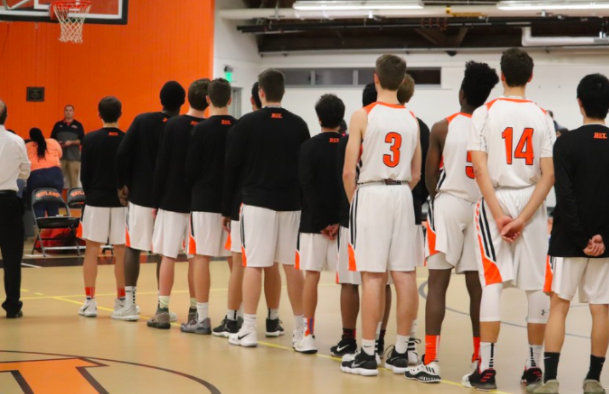Division vs. league: the differences explained
Wayland High School’s boys’ varsity basketball team is a division III team in the Dual County League. (Credit: Meredith Prince)
January 27, 2018
In Massachusetts Interscholastic Athletic Association (MIAA) sports, Wayland High School is part of the Dual County League (DCL). But what exactly defines a league?
According to WHS Athletic Director Heath Rollins, a league is traditionally based on geography.
“A league is your traditional groups of local towns close by that you play in every sport,” Rollins said.
In sports, the terms “division” and “league” both get tossed around regularly. Many people may not know the technical difference between the two. Different from leagues, divisions are based on a school’s population size.
“Some of the teams in our league are in a much higher division because their school population is different,” Rollins said. “The divisions are divided up based on population in the school.”
Although the DCL is one league, it is made up of three divisions. It is possible and common for more than one division to be in a single league.
“Within the DCL we have division III, division II and division I schools,” Rollins said.
In addition to divisions being determined by student population, they also depend on the number of schools in the state that offer that sport. If a sport is more popular and more schools offer it, the more divisions there will be.
“Some sports like soccer and basketball [are present in almost every school], so you’ll see a lot more divisions, which pushes [schools like WHS] down into division III,” Rollins said.
Teams are categorized within the league by size and ability (small and large). Teams with a larger number of students or with students with better abilities are generally placed in the large category, while smaller teams with fewer members are placed in the small category.
Different schools across the state also offer different types of sports. As a result, for any given school, the division that their different sports teams are in may also vary. Two different sports at the same school may be in completely different divisions depending on how many other schools in the state offer that sport.
“In tennis, we were in the division II state championship,” Rollins said. “In lacrosse, we were in division II as well. But our boys’ soccer team was in division III.”





![Last Wednesday, the Wayland School Committee gathered to discuss a number of topics regarding the health curriculum and Innovation Career Pathway course. Another large topic of conversation was the ways to potentially mitigate distracting cell phone usage. "These [phones] are going to distract your learning and social relationships," Superintendent David Fleishman said. "That's concrete right there."](https://waylandstudentpress.com/wp-content/uploads/2025/06/Screenshot-2025-06-04-at-9.49.31 PM-1200x886.png)



























![Troy Hoyt finishes the Boston Marathon, running for the Hoyt Foundation. T. Hoyt is the son of Hoyt Foundation CEO Russ Hoyt.
“[Running a marathon] might seem like a big thing, when it’s presented to you at first, but if you break it up and just keep telling yourself, “Yes, you can,” you can start chipping away at it. And before you know it, you’ll be running the whole 26 miles, and you won’t even think twice about it.” T. Hoyt said.](https://waylandstudentpress.com/wp-content/uploads/2025/04/C36E8761-1CBB-452E-9DF2-543EF7B1095E_1_105_c.jpeg)













































